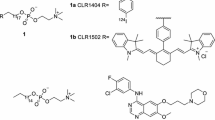Abstract
Purpose. To study the dual mechanism of action of FD137, a 3,3-disubstituted nitrosourea designed to block signaling mediated by the epidermal growth factor receptor (EGFR) on its own and to be hydrolyzed to an inhibitor of EGFR plus a DNA-damaging species.
Materials and methods. HPLC was used to determine the half-life (t1/2) of FD137 and to characterize its derived metabolite FD110. The dual mechanisms of DNA damaging and EGFR tyrosine kinase (TK) targeting were ascertained by the comet assay for DNA damage and by inmunodetection of phosphotyrosine in an ELISA and a whole-cell assay for EGFR-mediated signaling. The antiproliferative effects of the different drugs and their combinations were determined by the sulforhodamine B (SRB) assay.
Results. In contrast to BCNU, FD137 significantly blocked EGF-induced EGFR autophosphorylation (IC50 4 µM) in the human solid tumor cell line A431. DNA damage induced by FD137 could only be observed after 24 h exposure, but the level of DNA damage remained 3.6-fold lower than that induced by BCNU. This difference was rationalized by the 160-fold greater stability of FD137 when compared with BCNU in serum-containing medium. Further, degradation of FD137 was accompanied by the slow release of FD110, an extremely potent inhibitor of EGFR TK [IC50 (EGFR autophosphorylation) <0.3 µM]. The complex properties of FD137 translated into a 55-fold greater antiproliferative activity than BCNU against the EGFR-overexpressing A431 cells that coexpresses the O6-alkylguanine transferase (AGT). Depletion of AGT in these cells by the use of O6-benzylguanine (O6-BG) enhanced their sensitivity to BCNU by 8-fold, but only by 3-fold to FD137.
Conclusions. The results overall suggest that the superior antiproliferative activity of FD137 when compared with BCNU may be associated with its ability to behave as a combination of many species with different mechanisms of action. However, the enhancement of its potency by O6-BG suggests that its antiproliferative effect was at least partially mitigated by AGT and perhaps it may be largely dominated by its signal transduction inhibitory component.
Similar content being viewed by others
Author information
Authors and Affiliations
Additional information
Electronic Publication
Rights and permissions
About this article
Cite this article
Qiu, Q., Dudouit, F., Matheson, S.L. et al. The combi-targeting concept: a novel 3,3-disubstituted nitrosourea with EGFR tyrosine kinase inhibitory properties. Cancer Chemother Pharmacol 51, 1–10 (2003). https://doi.org/10.1007/s00280-002-0524-5
Received:
Accepted:
Issue Date:
DOI: https://doi.org/10.1007/s00280-002-0524-5




